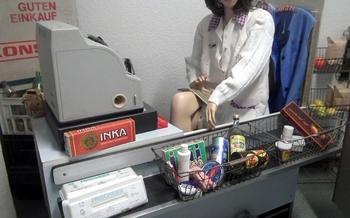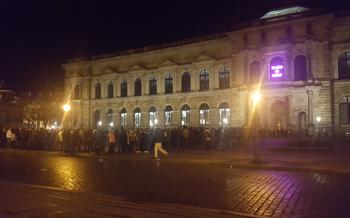
The Stasi Records Agency Dresden
- Location and Accessibility
- Opening Hours and Admission
- Exhibitions and Displays
- Guided Tours
- Research and Archives
- Educational Programs
- Personal Stories and Testimonies
- Memorial and Remembrance
- The Stasi Museum
- The Stasi Files
- Insider Tip
Location and Accessibility
The Stasi Records Agency Dresden is conveniently located in the heart of the city, at Bautzner Straße 1It is easily accessible by public transportation, with several tram and bus lines stopping nearby. The closest tram stop is "Bautzner Straße," which is served by lines 3, 7, and Several bus lines also stop within walking distance of the agency, including lines 61, 63, and 7For those arriving by car, there are several parking garages and street parking options available in the surrounding area.
Opening Hours and Admission
The Stasi Records Agency Dresden is open to the public from Tuesday to Sunday. The operating hours are from 10:00 AM to 6:00 PM. Visitors are advised to plan their visit accordingly to make the most of their time.
Admission to the agency is subject to a fee. The standard ticket price for adults is 8 euros, while reduced tickets for students, seniors, and disabled individuals are available for 6 euros. Families and groups of 10 or more people are also eligible for discounted rates.
The Stasi Records Agency Dresden offers free admission on the first Sunday of each month, providing an opportunity for visitors to explore the exhibitions and learn about the history of the Stasi without any financial burden.
Exhibitions and Displays
The Stasi Records Agency Dresden offers a range of permanent and temporary exhibitions that provide insights into the history and activities of the Stasi.
The permanent exhibitions include:
- The Stasi State Security Service in the GDR: This exhibition explores the structure and functioning of the Stasi, from its foundation to its dissolution.
- Everyday Life in the GDR: This exhibition examines the impact of the Stasi on the daily lives of East Germans, including the use of surveillance, intimidation, and repression.
- Resistance and Opposition in the GDR: This exhibition highlights the courageous individuals and groups who resisted the Stasi and fought for freedom and democracy in East Germany.
In addition to the permanent exhibitions, the Stasi Records Agency Dresden also hosts temporary exhibitions on a variety of topics related to the Stasi and its legacy. These exhibitions often feature personal stories, historical artifacts, and interactive displays.
Interactive displays are a key feature of the Stasi Records Agency Dresden, allowing visitors to engage with the history of the Stasi in a hands-on way. These displays include:
- The Stasi Files: This interactive display allows visitors to search through the Stasi's vast collection of files, which contain information on millions of East Germans.
- The Stasi Prison: This interactive display recreates the conditions of the Stasi prison, giving visitors a glimpse into the harsh realities of life for political prisoners in East Germany.
- The Stasi Headquarters: This interactive display allows visitors to explore the Stasi's former headquarters building, which is now a museum.
Guided Tours
The Stasi Records Agency Dresden offers guided tours of its exhibitions and facilities, providing an immersive and informative experience for visitors. These tours are led by knowledgeable guides who share insights into the agency's history, its role in East Germany, and its lasting impact on German society.
Availability and Languages Offered
Guided tours are available in German, English, and other languages upon request. Visitors are advised to book in advance, especially during peak tourist season, to secure a spot in a tour that suits their preferred language and time. Group tours can also be arranged for larger groups or educational institutions.
Booking Procedure
To book a guided tour, visitors can either call the agency or reserve their spot online through the official website. When booking online, visitors can choose their preferred date and time, as well as the language of the tour. Payment for the tour can be made online or on-site at the agency.
Research and Archives
The Stasi Records Agency Dresden is a treasure trove for researchers and historians interested in the inner workings of the Stasi and the history of East Germany. The agency houses a vast collection of Stasi records, including surveillance files, interrogation reports, and personal documents. These records provide a unique glimpse into the lives of Stasi victims and the methods used by the secret police to maintain control over the population.
Access to Stasi Records
Researchers can access the Stasi records by submitting a written request to the agency. The request should include the specific documents or files that the researcher is interested in, as well as a justification for the research. Once the request has been approved, researchers can view the documents in the agency's reading room.
Research Facilities
The Stasi Records Agency Dresden provides researchers with a range of facilities to support their work. These facilities include a library, a microfilm reader, and a computer lab. Researchers can also request assistance from the agency's staff, who are experts in the field of Stasi research.
Requesting Copies of Documents
Researchers can request copies of Stasi documents for a fee. The fees vary depending on the number of documents requested and the format of the copies. Researchers can request copies in paper or electronic format.
Educational Programs
The Stasi Records Agency Dresden offers a range of educational programs to promote understanding of the Stasi's history and its impact on East German society. These programs are designed for various audiences, including students, researchers, and the general public.
Workshops and Seminars: The agency hosts workshops and seminars on various topics related to the Stasi, such as surveillance techniques, the role of informers, and the experiences of Stasi victims. These programs provide a deeper understanding of the Stasi's inner workings and its far-reaching consequences.
School Programs: The agency offers educational programs tailored to school groups, allowing students to learn about the Stasi's history and its relevance to contemporary society. Through interactive activities, discussions, and guided tours, students gain insights into the Stasi's oppressive tactics and the importance of promoting human rights and democracy.
Public Lectures: The agency regularly organizes public lectures by experts in the field of Stasi research, history, and human rights. These lectures provide opportunities for the general public to learn from leading scholars and practitioners and engage in discussions on various aspects of the Stasi's legacy.
Personal Stories and Testimonies
The Stasi Records Agency Dresden also houses a collection of personal stories and testimonies from victims of the Stasi regime. These include oral history interviews, written accounts, and interactive storytelling displays. Visitors can listen to firsthand accounts of people who were persecuted, imprisoned, or otherwise affected by the Stasi. These personal stories offer a powerful and moving insight into the human toll of the Stasi's surveillance and repression. They serve as a reminder of the importance of remembering and learning from the past, and of the resilience of the human spirit in the face of adversity.
One of the most poignant exhibits is a collection of letters written by Stasi prisoners to their loved ones. These letters, often written on scraps of paper and smuggled out of prison, express the prisoners' hopes, fears, and longing for freedom. They are a testament to the strength and determination of those who resisted the Stasi's attempts to silence them.
Another highlight of the collection is a series of interactive storytelling displays that allow visitors to experience the Stasi's surveillance methods firsthand. Visitors can listen to recorded phone calls, read intercepted letters, and examine Stasi files on ordinary citizens. These displays provide a glimpse into the Stasi's vast network of informants and the pervasive surveillance that was a hallmark of life in East Germany.
The Stasi Records Agency Dresden is a powerful and moving tribute to the victims of the Stasi regime. The personal stories and testimonies on display offer a unique and unforgettable insight into the human cost of dictatorship.
Memorial and Remembrance
The Stasi Records Agency Dresden also serves as a memorial and a place of remembrance for the victims of the Stasi regime. Commemoration ceremonies and memorial events are held regularly to honor those who suffered under the Stasi's oppression. These events provide an opportunity for reflection and remembrance, and they help to keep the memory of the victims alive.
The agency also supports various remembrance initiatives, such as the creation of memorials and educational programs. These initiatives aim to raise awareness about the Stasi's crimes and to ensure that the victims are never forgotten. By preserving the memory of the past, the agency helps to prevent similar atrocities from happening again.
One of the most poignant ways to remember the victims of the Stasi is through the personal stories and testimonies of those who experienced the regime's brutality firsthand. The agency collects and preserves these stories, and they are shared through exhibitions, publications, and educational programs. These personal accounts provide a powerful reminder of the human cost of the Stasi's oppression, and they help to ensure that the victims' experiences are not forgotten.
The Stasi Museum
The Stasi Museum, located within the former Stasi headquarters, offers a comprehensive and immersive exploration of the Stasi's history and its impact on East German society. Through interactive exhibits, historical artifacts, and thematic displays, visitors gain a deeper understanding of the Stasi's surveillance methods, the lives of its victims, and the broader context of the Cold War.
One of the highlights of the museum is the "Stasi Files" exhibition, which showcases a vast collection of documents, photographs, and personal belongings confiscated by the Stasi. Visitors can examine these files and learn about the methods used by the Stasi to collect information and monitor citizens' activities. The exhibition also explores the role of informers and the devastating consequences for those who were targeted by the Stasi.
Another section of the museum focuses on the Stasi's "Zersetzung" tactics, which were designed to undermine and destroy the lives of dissidents and political opponents. Visitors can learn about the psychological warfare techniques employed by the Stasi, including surveillance, harassment, and character assassination. Personal accounts from victims of "Zersetzung" provide a poignant and deeply moving perspective on the human toll of the Stasi's repression.
The Stasi Museum also offers a glimpse into the daily lives of Stasi officers, showcasing their uniforms, equipment, and personal effects. Visitors can gain insights into the motivations and mindsets of those who worked for the Stasi, as well as the broader social and political forces that shaped their actions.
Overall, the Stasi Museum provides a powerful and thought-provoking exploration of one of the most notorious secret police organizations in history. Through its interactive exhibits, historical artifacts, and personal stories, the museum offers a unique opportunity to learn about the Stasi's methods, its impact on East German society, and the broader context of the Cold War.
The Stasi Files
The Stasi maintained a vast network of surveillance, employing a variety of methods to collect information on East German citizens. These methods included:
-
Informers: The Stasi recruited a vast network of informers, who were often ordinary citizens who were coerced or bribed into spying on their friends, family, and colleagues.
-
Surveillance: The Stasi conducted extensive surveillance on the population, using wiretaps, hidden cameras, and other methods to monitor people's conversations, movements, and activities.
-
Interrogations: The Stasi routinely interrogated people who were suspected of being dissidents or enemies of the state. These interrogations were often brutal and could last for hours or even days.
-
Detention: The Stasi maintained a network of detention centers where people who were suspected of being dissidents were held without trial. These detention centers were often overcrowded and unsanitary, and the conditions for prisoners were often harsh.
The Stasi's surveillance and control extended to all aspects of life in East Germany. It was virtually impossible for East Germans to escape the Stasi's gaze, and the fear of being spied on and reported to the authorities was pervasive. The Stasi's files provide a chilling glimpse into the extent of surveillance and control that was exercised by the East German secret police.
Insider Tip
To make the most of your visit, consider attending a themed event or workshop offered by the Stasi Records Agency Dresden. These events provide a unique opportunity to delve deeper into specific aspects of Stasi history and its impact on East German society. Check the agency's website or inquire at the information desk for upcoming events.
After exploring the agency, take some time to wander through the surrounding neighborhood. The nearby Alaunpark, with its lush greenery and serene atmosphere, offers a tranquil contrast to the heavy subject matter of the Stasi records. You can also visit the nearby Kunsthofpassage, a vibrant alleyway adorned with colorful murals and sculptures, showcasing Dresden's vibrant art scene.
To make the most of your time in Dresden, combine your visit to the Stasi Records Agency with other attractions in the city. The nearby Dresden Zwinger, a magnificent Baroque palace, houses several museums, including the Gemäldegalerie Alte Meister, with its collection of Old Master paintings. The Frauenkirche, a stunning Lutheran church rebuilt after being destroyed during World War II, is another must-see landmark. A short tram ride away, you can visit the Deutsches Hygiene-Museum, which explores the history of medicine and public health from a unique perspective.









